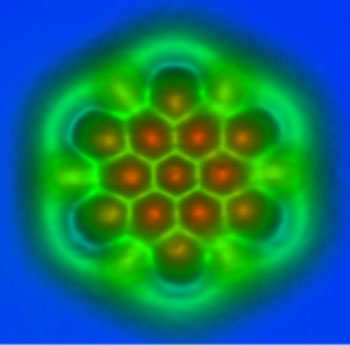| Sep 13, 2012 |
IBM scientists first to distinguish individual molecular bonds
|
|
(Nanowerk News) IBM scientists have been able to differentiate the chemical bonds in individual molecules for the first time using a technique known as noncontact atomic force microscopy (AFM).
|
|
The results push the exploration of using molecules and atoms at the smallest
scale and could be important for studying graphene devices, which are currently
being explored by both industry and academia for applications including highbandwidth
wireless communication and electronic displays.
|
|
“We found two different contrast mechanisms to distinguish bonds. The first one is
based on small differences in the force measured above the bonds. We expected
this kind of contrast but it was a challenge to resolve,” said IBM scientist Leo
Gross. “The second contrast mechanism really came as a surprise: Bonds
appeared with different lengths in AFM measurements. With the help of ab initio
calculations we found that the tilting of the carbon monoxide molecule at the tip
apex is the cause of this contrast.”
|
 |
| A nanographene molecule exhibiting carbon-carbon bonds of different length and bond order imaged by noncontact atomic force microscopy using a carbon monoxide functionalized tip. This molecule was synthesized at the Centre National de la Recherche Scientifique (CNRS) in Toulouse. (Image: IBM Research - Zurich)
|
|
As reported in the cover story of the September 14th issue of Science magazine ("Bond-Order Discrimination by Atomic Force Microscopy"),
IBM Research scientists imaged the bond order and length of individual carboncarbon
bonds in C60, also known as a buckyball for its football shape and two
planar polycyclic aromatic hydrocarbons (PAHs), which resemble small flakes of
graphene. The PAHs were synthesized by Centro de Investigación en Química
Biolóxica e Materiais Moleculares (CIQUS) at the Universidade de Santiago de
Compostela and Centre National de la Recherche Scientifique (CNRS) in Toulouse.
|
|
The individual bonds between carbon atoms in such molecules differ subtly in their
length and strength. All the important chemical, electronic, and optical properties
of such molecules are related to the differences of bonds in the polyaromatic
systems. Now, for the first time, these differences were detected for both
individual molecules and bonds. This can increase basic understanding at the level
of individual molecules, important for research on novel electronic devices, organic
solar cells, and organic light-emitting diodes (OLEDs). In particular, the relaxation
of bonds around defects in graphene as well as the changing of bonds in chemical
reactions and in excited states could potentially be studied.
|
|
As in their earlier research ("The Chemical Structure of a Molecule Resolved by Atomic Force Microscopy") the IBM scientists used an
atomic force microscope (AFM) with a tip that is terminated with a single carbon
monoxide (CO) molecule. This tip oscillates with a tiny amplitude above the sample
to measure the forces between the tip and the sample, such as a molecule, to
create an image. The CO termination of the tip acts as a powerful magnifying glass
to reveal the atomic structure of the molecule, including its bonds. This made it
possible to distinguish individual bonds that differ only by 3 picometers or 3 × 10-12
meters, which is about one-hundredth of an atom’s diameter.
|
|
In previous research the team succeeded in imaging the chemical structure of a
molecule, but not the subtle differences of the bonds. Discriminating bond order is
close to the current resolution limit of the technique and often other effects
obscure the contrast related to bond order. Therefore the scientists had to select
and synthesize molecules in which perturbing background effects could be ruled
out.
|
|
To corroborate the experimental findings and gain further insight into the exact
nature of the contrast mechanisms, the team performed first-principles density
functional theory calculations. Thereby they calculated the tilting of the CO
molecule at the tip apex that occurs during imaging. They found how this tilting
yields a magnification and the very sharp images of the bonds.
|
|
This research was funded within the framework of several European projects
including ARTIST, HERODOT, CEMAS, the Spanish Ministry of Economy and
Competitiveness and the Regional Government of Galicia.
|

